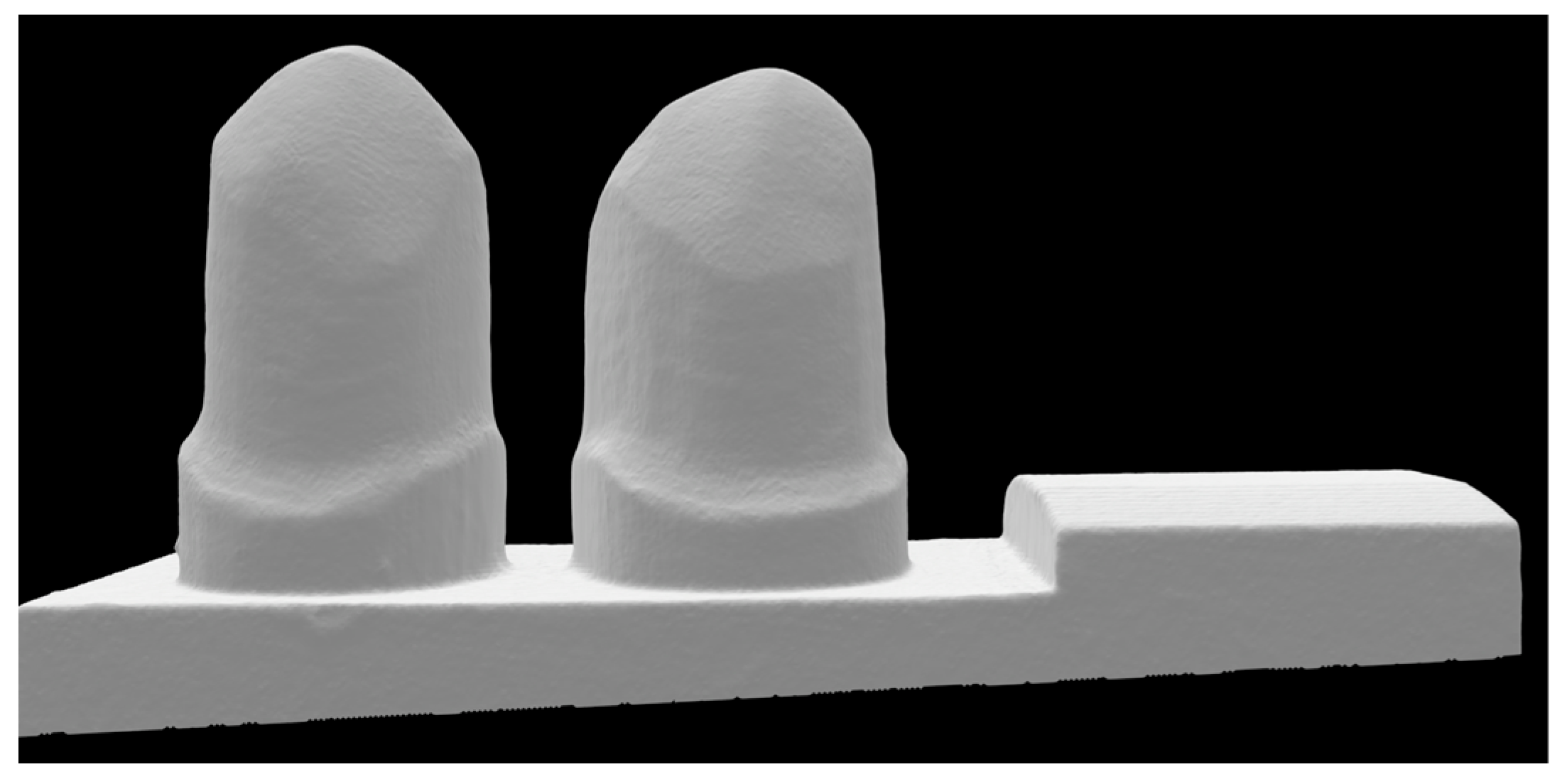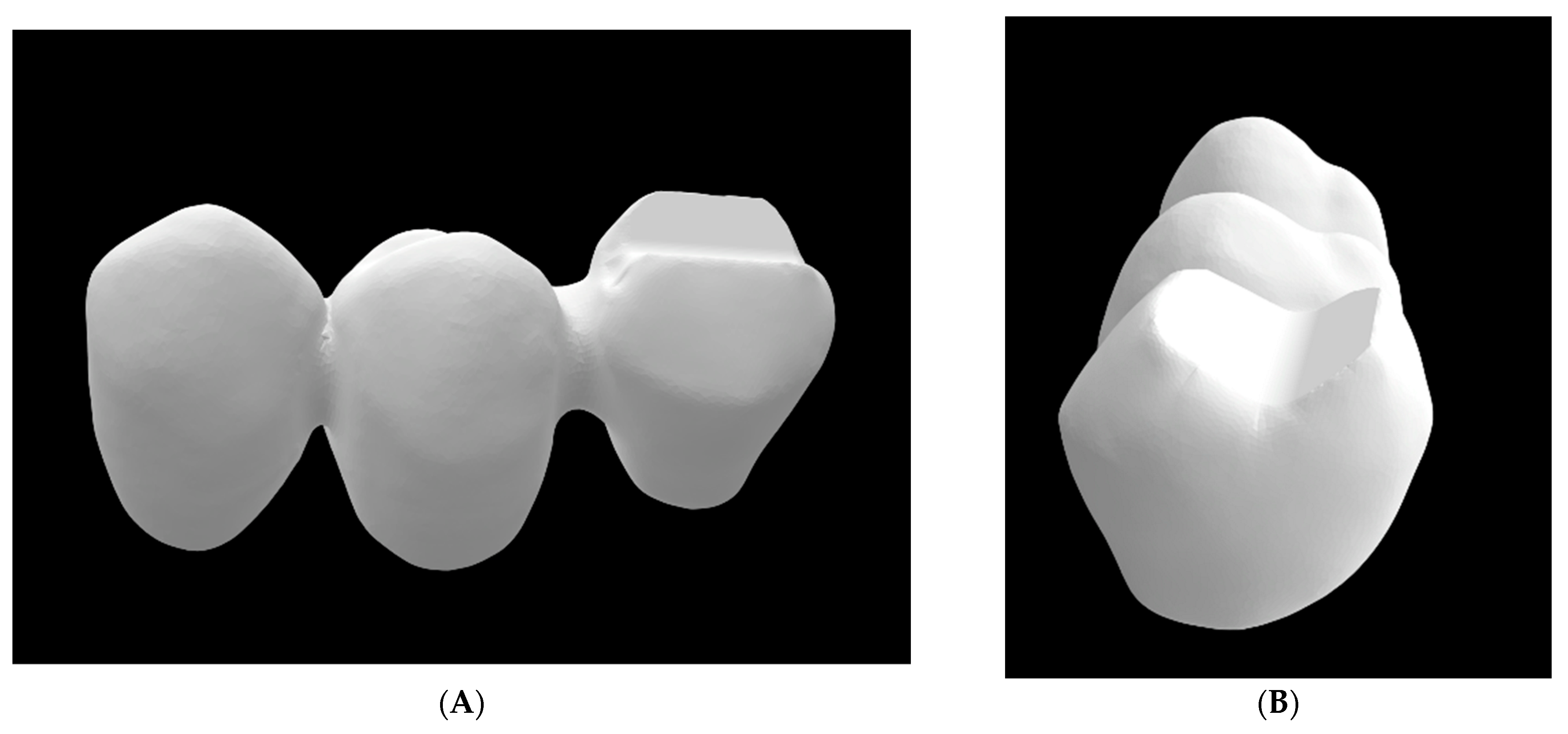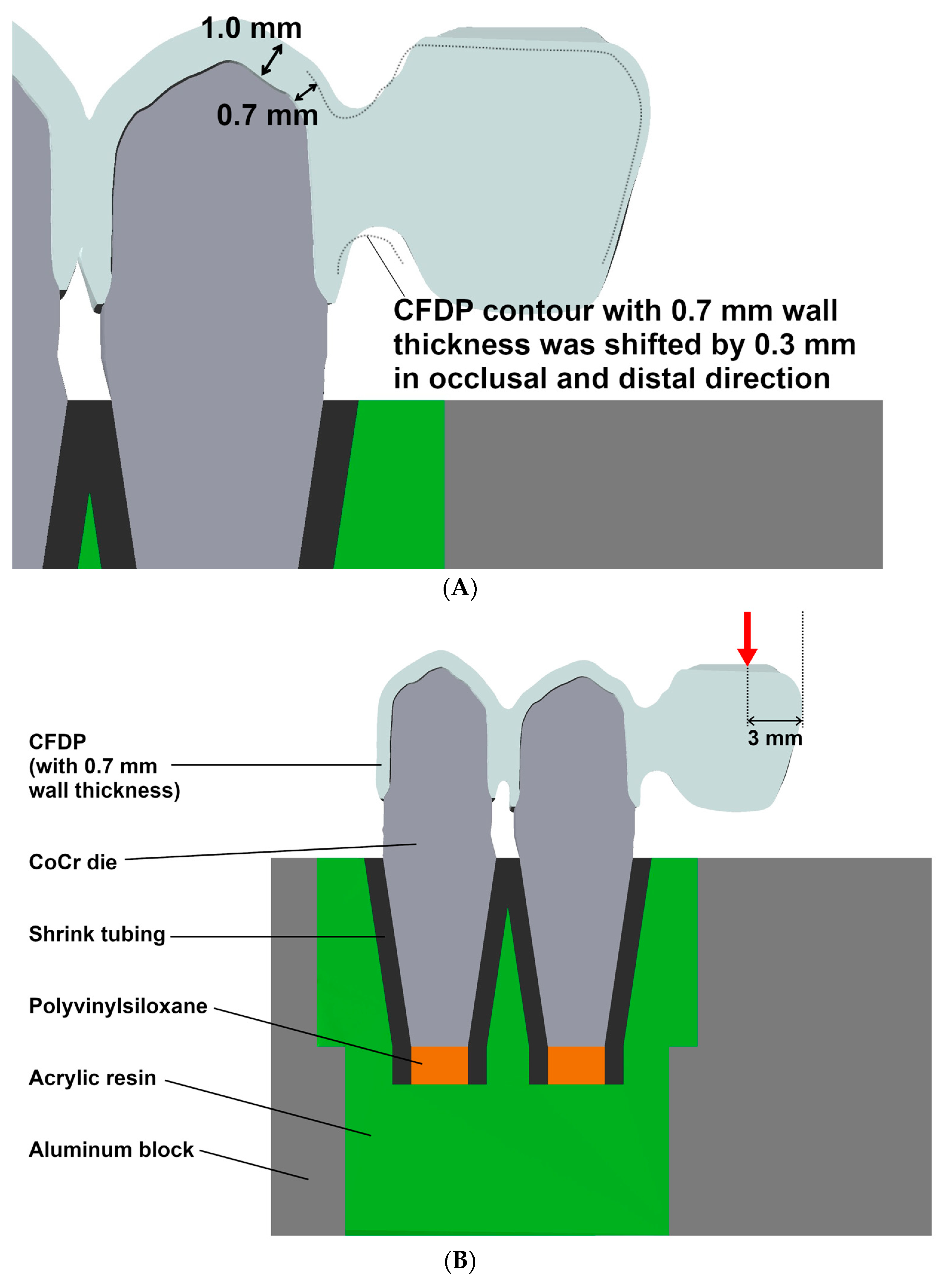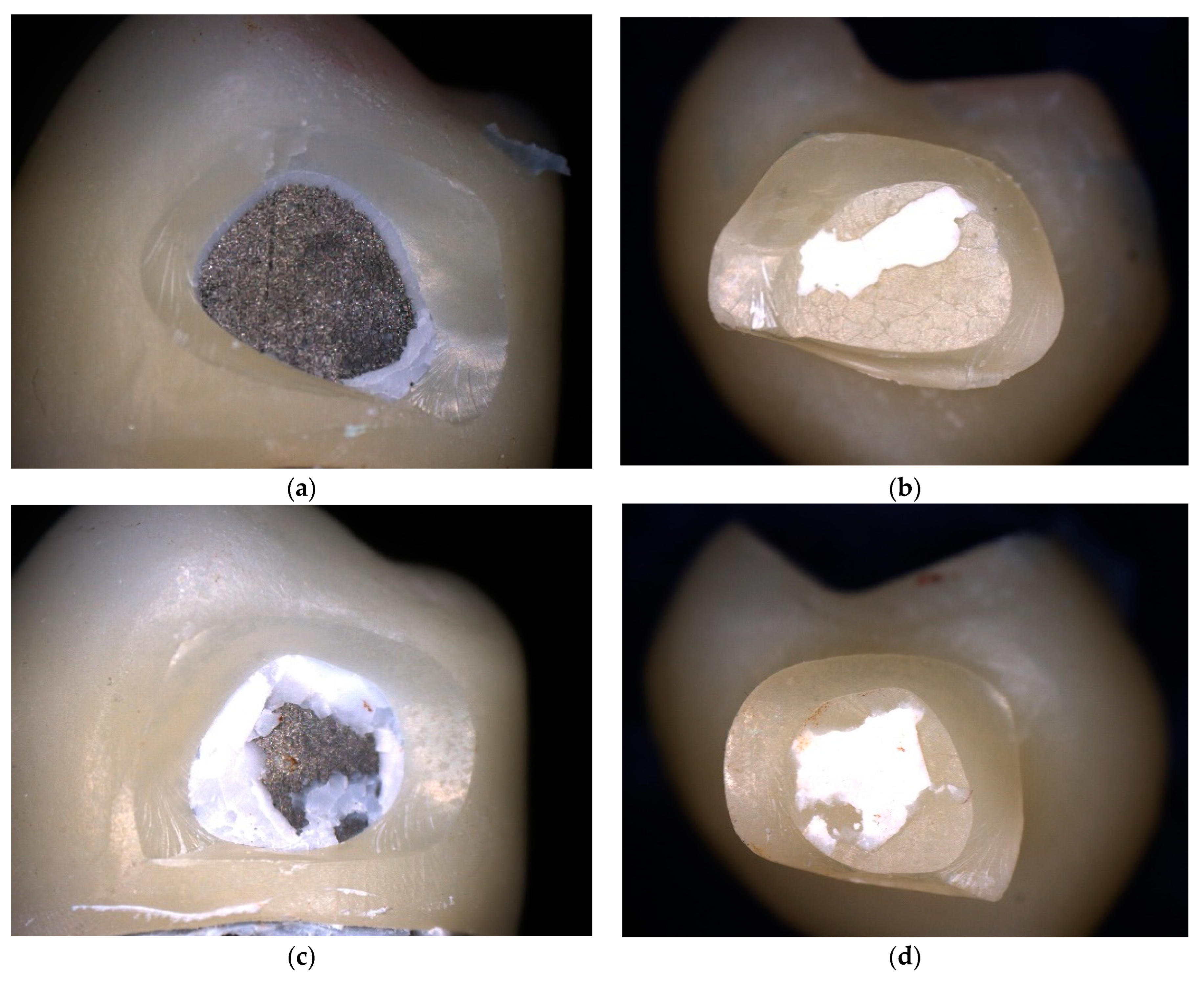Fracture Resistance of Posterior Tooth-Supported Cantilever Fixed Dental Prostheses of Different Zirconia Generations and Framework Thicknesses: An In Vitro Study
Abstract
1. Introduction
2. Materials and Methods
2.1. Study Design
2.2. CFDP Design and Fabrication
2.3. Production of the Cobalt-Chromium Alloy Tooth Analogs
2.4. Fabrication of the Typodont Replicas
2.5. Cementation
2.6. Artificial Aging/Chewing Simulation
2.7. Fracture Load Test
2.8. Statistical Analysis
3. Results
3.1. Artificial Aging
3.2. Fracture Resistance
4. Discussion
Limitations
5. Conclusions
Author Contributions
Funding
Institutional Review Board Statement
Informed Consent Statement
Data Availability Statement
Acknowledgments
Conflicts of Interest
References
- Pjetursson, B.E.; Sailer, I.; Makarov, N.A.; Zwahlen, M.; Thoma, D.S. All-ceramic or metal-ceramic tooth-supported fixed dental prostheses (FDPs)? A systematic review of the survival and complication rates. Part II: Multiple-unit FDPs. Dent. Mater. 2015, 31, 624–639. [Google Scholar] [CrossRef] [PubMed]
- Pjetursson, B.E.; Lang, N.P. Prosthetic treatment planning on the basis of scientific evidence. J. Oral. Rehabil. 2008, 35 (Suppl. S1), 72–79. [Google Scholar] [CrossRef] [PubMed]
- Pjetursson, B.E.; Tan, K.; Lang, N.P.; Bragger, U.; Egger, M.; Zwahlen, M. A systematic review of the survival and complication rates of fixed partial dentures (FPDs) after an observation period of at least 5 years. Clin. Oral. Implants Res. 2004, 15, 667–676. [Google Scholar] [CrossRef] [PubMed]
- Rehmann, P.; Podhorsky, A.; Wöstmann, B. Treatment Outcomes of Cantilever Fixed Partial Dentures on Vital Abutment Teeth: A Retrospective Analysis. Int. J. Prosthodont. 2015, 28, 577–582. [Google Scholar] [CrossRef] [PubMed]
- Klotz, A.L.; Rammelsberg, P.; Zenthöfer, A. Extensionsbrücken-ein Praxisorientiertes Update. Quintessenz 2017, 68, 1–18. [Google Scholar]
- Hälg, G.A.; Schmid, J.; Hämmerle, C.H. Bone level changes at implants supporting crowns or fixed partial dentures with or without cantilevers. Clin. Oral. Implant. Res. 2008, 19, 983–990. [Google Scholar] [CrossRef]
- Kim, P.; Ivanovski, S.; Latcham, N.; Mattheos, N. The impact of cantilevers on biological and technical success outcomes of implant-supported fixed partial dentures. A retrospective cohort study. Clin. Oral. Implants Res. 2014, 25, 175–184. [Google Scholar] [CrossRef]
- Christensen, R.P.; Ploeger, B.J. A clinical comparison of zirconia, metal and alumina fixed-prosthesis frameworks veneered with layered or pressed ceramic: A three-year report. J. Am. Dent. Assoc. 2010, 141, 1317–1329. [Google Scholar] [CrossRef]
- Denry, I.; Kelly, J.R. State of the art of zirconia for dental applications. Dent. Mater. 2008, 24, 299–307. [Google Scholar] [CrossRef]
- Guazzato, M.; Albakkry, M.; Ringer, S.P.; Swain, M.V. Strength, fracture toughness ans microstructure of a selection of all-ceramic materials. Part ii. Zirconia-based dental ceramics. Dent. Mater. 2004, 20, 449–456. [Google Scholar] [CrossRef]
- Piconi, C.; Maccauro, F. Zirconia as a ceramic biomaterial. Biomaterials 1999, 20, 1–25. [Google Scholar] [CrossRef] [PubMed]
- Rosentritt, M.; Preis, V.; Behr, M.; Strasser, T. Fatigue and wear behaviour of zirconia materials. J. Mech. Behav. Biomed. Mater. 2020, 110, 103970. [Google Scholar] [CrossRef] [PubMed]
- Zhang, Y.; Lawn, B.R. Novel Zirconia Materials in Dentistry. J. Dent. Res. 2018, 97, 140–147. [Google Scholar] [CrossRef] [PubMed]
- Schmidt, M.B.; Rosentritt, M.; Hahnel, S.; Wertz, M.; Hoelzig, H.; Kloess, G.; Koenig, A. Fracture behavior of cantilever fixed dental prostheses fabricated from different zirconia generations. Quintessence Int. 2022, 53, 414–422. [Google Scholar] [CrossRef] [PubMed]
- Kongkiatkamon, S.; Rokaya, D.; Kengtanyakich, S.; Peampring, C. Current classification of zirconia in dentistry: An updated review. PeerJ 2023, 11, e15669. [Google Scholar] [CrossRef] [PubMed]
- IPS e.max ZirCAD Prime-Familie: Ivoclar. Available online: www.ivoclar.com/primeesthetic_testangebot?utm_source=Google&utm_medium=Search+Paid&utm_campaign=DE+e.max+Zirkon+2023 (accessed on 19 October 2023).
- Tzanakakis, E.; Tzoutzas, I.; Kontonasaki, E. Zirconia: Contemporary views of a much talked material: Structure, applications and clinical considerations. Hel. Stom. Rev. 2013, 57, 101–137. [Google Scholar]
- Ohlmann, B.; Dittmar, A.; Rues, S.; Rammelsberg, P. Comparison of fracture-load values of cantilevered FDPs. Acta Odontol. Scand. 2013, 71, 584–589. [Google Scholar] [CrossRef]
- Ohlmann, B.; Marienburg, K.; Gabbert, O.; Hassel, A.; Gilde, H.; Rammelsberg, P. Fracture-load values of all-ceramic cantilevered FPDs with different framework designs. Int. J. Prosthodont. 2009, 22, 49–52. [Google Scholar]
- Jerg, A.; Spitznagel, F.; Ahlers, O.; Beck, J.; Beuer, F.; Struck, R.; Christelsohn, K.; Reiss, B.; Güth, J.F.; Kern, M.; et al. Update of the S3 guideline “all-ceramic single crowns and fixed dental prostheses”-current evidence-based recommendations. DZZ Int. 2021, 3, 248–256. [Google Scholar]
- Edelhoff, D.; Sorensen, J.A. Thooth structure removal associated with various preparation designs for posterior teeth. Int. J. Prosthodont. Restor. Dent. 2022, 22, 241–249. [Google Scholar]
- Krejci, I.; und Lutz, F. In-vitro test results of the evaluation of dental restoration systems. Correlation with in-vivo results. Schweiz Monatsschr. Zahnmed. 1990, 100, 1445–1449. [Google Scholar] [PubMed]
- DeLong, R.; Sakaguchi, R.L.; Douglas, W.H.; und Pintado, M.R. The wear of dental amalgam in an artificial mouth: A clinical correlation. Dent. Mater. 1985, 1, 238–242. [Google Scholar] [CrossRef] [PubMed]
- Sakaguchi, R.L.; Douglas, W.H.; DeLong, R.; und Pintado, M.R. The wear of a posterior composite in an artificial mouth: A clinical correlation. Dent. Mater. 1986, 2, 235–240. [Google Scholar] [CrossRef] [PubMed]
- Rosentritt, M.; Preis, V.; Schmid, A.; Strasser, T. Multilayer zirconia: Influence of positioning within blank and sintering conditions on the in vitro performance of 3-unit fixed partial dentures. J. Prosthet. Dent. 2022, 127, 141–145. [Google Scholar] [CrossRef] [PubMed]
- Bahgat, S.F.A.; Katamish, H.; und El-Guindy, J. Fracture strength of yttria-stabilized zirconium-dioxide (Y-TZP) fixed dental prostheses (FDPs) with different abutment core thicknesses and connector dimensions. J. Prosthodont. 2013, 22, 377–382. [Google Scholar]
- Bahgat, S.F.A.; Katamish, H.; und El-Guindy, J. Effect of connector dimension on the fracture characteristics of cantilever posterior Zirconia bridges. Ain Shams Dent. J. 2017, 20, 71–84. [Google Scholar]
- Rosentritt, M.; Behr, M.; Gebhard, R.; und Handel, G. Influence of stress simulation parameters on the fracture strength of all-ceramic fixed-partial dentures. Dent. Mater. 2006, 22, 176–182. [Google Scholar] [CrossRef]
- Waldecker, M.; Rues, S.; Rammelsberg, P.; und Bömicke, W. Validation of in-vitro tests of zirconia-ceramic inlay-retained fixed partial dentures: A finite element analysis. Dent. Mater. 2019, 35, e53–e62. [Google Scholar] [CrossRef]
- Wimmer, T.; Erdelt, K.J.; Eichberger, M.; Roos, M.; Edelhoff, D.; und Stawarczyk, B. Influence of abutment model materials on the fracture loads of three-unit fixed dental prostheses. Dent. Mater. J. 2014, 33, 717–724. [Google Scholar] [CrossRef]
- Rosentritt, M.; Behr, M.; Scharnagl, P.; Handel, G.; und Kolbeck, C. Influence of resilient support of abutment teeth on fracture resistance of all-ceramic fixed partial dentures: An in vitro study. Int. J. Prosthodont. 2011, 24, 465–468. [Google Scholar]
- Schindler, H.J.; Stengel, E.; und Spiess, W.E. Feedback control during mastication of solid food textures--a clinical-experimental study. J. Prosthet. Dent. 1998, 80, 330–336. [Google Scholar] [CrossRef] [PubMed]
- Lundgren, D.; und Laurell, L. Occlusal force pattern during chewing and biting in dentitions restored with fixed bridges of cross-arch extension. J. Oral Rehabil. 1986, 13, 57–71. [Google Scholar] [CrossRef] [PubMed]
- Wolfart, S.; Ludwig, K.; Uphaus, A.; und Kern, M. Fracture strength of all-ceramic posterior inlay-retained fixed partial dentures. Dent. Mater. 2007, 23, 1513–1520. [Google Scholar] [CrossRef] [PubMed]
- Körber, K.H. Maximum masticatory force as a calculation factor of dental constructions. Dent. Lab 1983, 31, 55–60. [Google Scholar]
- Čokić, S.M.; Cóndor, M.; Vleugels, J.; Meerbeek, B.V.; Oosterwyck, H.V.; Inokoshi, M.; Zhang, F. Mechanical properties-translucency-microstructure relationships in commercial monolayer and multilayer monolithic zirconia ceramics. Dent. Mater. 2022, 38, 797–810. [Google Scholar] [CrossRef]
- Guazzato, M.; Proos, K.; Quach, L.; und Swain, M.V. Strength, reliability and mode of fracture of bilayered porcelain/zirconia (Y-TZP) dental ceramics. Biomaterials 2004, 25, 5045–5052. [Google Scholar] [CrossRef]
- Eraslan, O.; Sevimay, M.; Usumez, A.; und Eskitascioglu, G. Effects of cantilever design and material on stress distribution in fixed partial dentures–a finite element analysis. J. Oral Rehabil. 2005, 32, 273–278. [Google Scholar] [CrossRef]
- Keulemans, F.; Shinya, A.; Lassila, L.V.; Vallittu, P.K.; Kleverlaan, C.J.; Feilzer, A.J.; und De Moor, R.J. Three-dimensional finite element analysis of anterior two-unit cantilever resin-bonded fixed dental prostheses. Sci. World J. 2015, 2015, 864389. [Google Scholar] [CrossRef]
- Zhang, Z.; Zhou, S.; Li, E.; Li, W.; Swain, M.V.; und Li, Q. Design for minimizing fracture risk of all-ceramic cantilever dental bridge. Biomed. Mater. Eng. 2015, 26 (Suppl. S1), S19–S25. [Google Scholar] [CrossRef]
- van den Breemer, C.R.; Gresnigt, M.M.M.; Cune, M.S. Cementation of Glass-Ceramic Posterior Restorations: A Systematic Review. Biomed. Res. Int. 2015, 2015, 148954. [Google Scholar] [CrossRef]
- Alammar, A.; Blatz, M.B. The resin bond to high-translucent zirconia-A systematic review. J. Esthet. Restor. Dent. 2022, 34, 117–135. [Google Scholar] [CrossRef] [PubMed]
- Blatz, M.B.; Vonderheide, M.; Conejo, J. The Effect of Resin Bonding on Long-Term Success of High-Strength Ceramics. J. Dent. Res. 2018, 97, 132–139. [Google Scholar] [CrossRef] [PubMed]
- Kelly, J. Approaching clinical relevance in failure testing of restorations. J. Prosthet. Dent. 1999, 81, 652–661. [Google Scholar] [CrossRef] [PubMed]
- Aboushelib, M.N.; Feilzer, A.J.; und Kleverlaan, C.J. Bridging the gap between clinical failure and laboratory fracture strength tests using a fractographic approach. Dent. Mater. 2009, 25, 383–391. [Google Scholar] [CrossRef]







| Test Group | Sample Size | Zirconia Blank Type | Wall Thickness |
|---|---|---|---|
| 3Y-0.7 | N = 8 | IPS e.max ZirCAD LT | 0.7 mm |
| ML 3Y/5Y-0.7 | N = 8 | IPS e.max ZirCAD Prime | 0.7 mm |
| ML 4Y/5Y-0.7 | N = 8 | IPS e.max ZirCad Prime Esthetic | 0.7 mm |
| ML 3Y/5Y-1.0 | N = 8 | IPS e.max ZirCAD Prime | 1.0 mm |
| ML 4Y/5Y-1.0 | N = 8 | IPS e.max ZirCad Prime Esthetic | 1.0 mm |
| Zirconia Type | Phase Composition [%] | Material Parameters | ||
|---|---|---|---|---|
| Tetr. | Cubic | Flexural Strength [MPa] | Fracture Toughness [MPa m0.5] | |
| 3Y-TZP | 100 | 0 | 1000 ± 200 | 5.00 ± 0.25 |
| 4Y-PSZ | 75 | 25 | 850 ± 100 | 3.75 ± 0.25 |
| 5Y-PSZ | 50 | 50 | 650 ± 50 | 3.75 ± 0.25 |
| Test Group | Number of Failures during Chewing Simulation | Fracture Resistance [N] | Rank [22,23,24] | ||
|---|---|---|---|---|---|
| Mean Value | Standard Deviation | Mean Value | Standard Deviation | ||
| 3Y-0.7 | - | 571 | 85 | 35.8 | 3.4 |
| ML 3Y/5Y-0.7 | - | 330 | 82 | 15.6 | 9.1 |
| ML 3Y/5Y-1.0 | 1 | 363 | 134 | 15.4 | 10.7 |
| ML 4Y/5Y-0.7 | 2 | 290 | 128 | 21.6 | 11.6 |
| ML 4Y/5Y-1.0 | 1 | 291 | 82 | 14.1 | 6.9 |
| Factor/Factor Combination | F | p-Value |
|---|---|---|
| Blank type | 14.768 | <0.001 |
| Wall thickness | 0.578 | 0.452 |
| Blank type * Wall thickness | 1.346 | 0.254 |
Disclaimer/Publisher’s Note: The statements, opinions and data contained in all publications are solely those of the individual author(s) and contributor(s) and not of MDPI and/or the editor(s). MDPI and/or the editor(s) disclaim responsibility for any injury to people or property resulting from any ideas, methods, instructions or products referred to in the content. |
© 2024 by the authors. Licensee MDPI, Basel, Switzerland. This article is an open access article distributed under the terms and conditions of the Creative Commons Attribution (CC BY) license (https://creativecommons.org/licenses/by/4.0/).
Share and Cite
Klotz, A.-L.; Halfmann, J.; Rues, S.; Bömicke, W.; Rammelsberg, P.; Zenthöfer, A. Fracture Resistance of Posterior Tooth-Supported Cantilever Fixed Dental Prostheses of Different Zirconia Generations and Framework Thicknesses: An In Vitro Study. Materials 2024, 17, 263. https://doi.org/10.3390/ma17010263
Klotz A-L, Halfmann J, Rues S, Bömicke W, Rammelsberg P, Zenthöfer A. Fracture Resistance of Posterior Tooth-Supported Cantilever Fixed Dental Prostheses of Different Zirconia Generations and Framework Thicknesses: An In Vitro Study. Materials. 2024; 17(1):263. https://doi.org/10.3390/ma17010263
Chicago/Turabian StyleKlotz, Anna-Luisa, Janina Halfmann, Stefan Rues, Wolfgang Bömicke, Peter Rammelsberg, and Andreas Zenthöfer. 2024. "Fracture Resistance of Posterior Tooth-Supported Cantilever Fixed Dental Prostheses of Different Zirconia Generations and Framework Thicknesses: An In Vitro Study" Materials 17, no. 1: 263. https://doi.org/10.3390/ma17010263
APA StyleKlotz, A.-L., Halfmann, J., Rues, S., Bömicke, W., Rammelsberg, P., & Zenthöfer, A. (2024). Fracture Resistance of Posterior Tooth-Supported Cantilever Fixed Dental Prostheses of Different Zirconia Generations and Framework Thicknesses: An In Vitro Study. Materials, 17(1), 263. https://doi.org/10.3390/ma17010263








